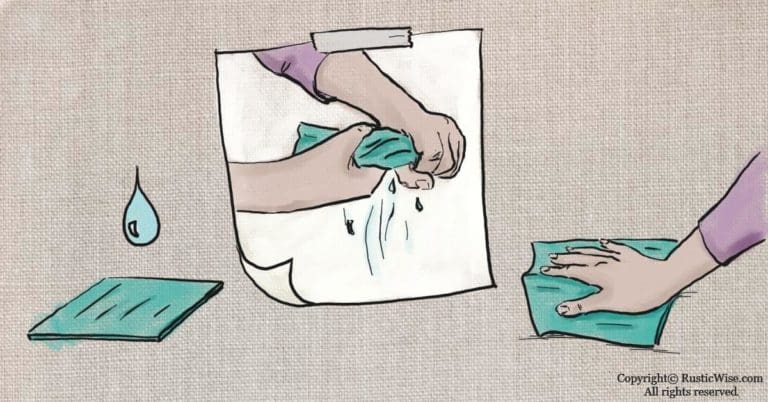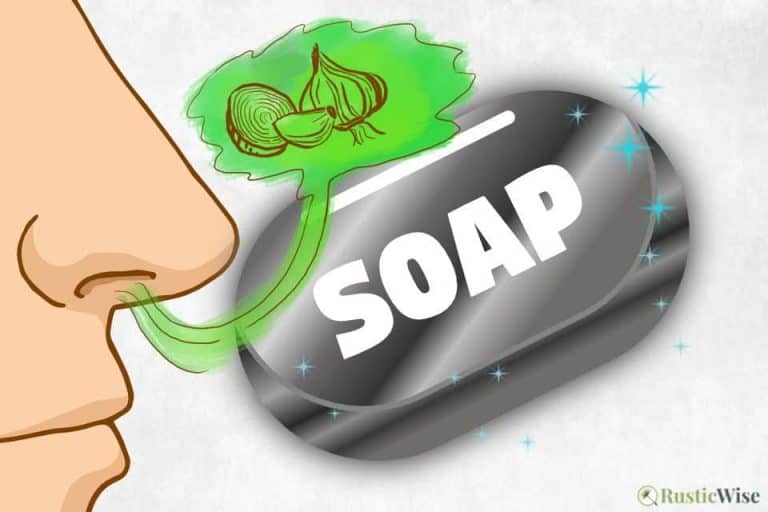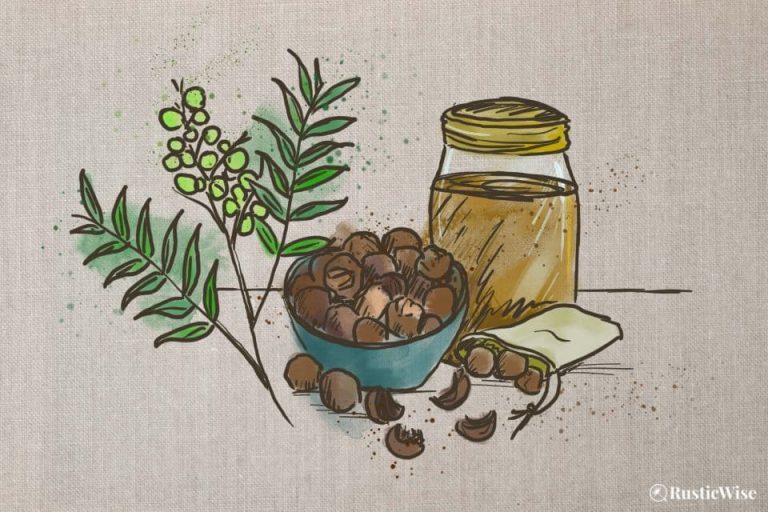8 Castile Soap Warnings You Should Know
Eco-friendly, plant-based, and an all-purpose soap great for household and personal care purposes, there are many Castile soap benefits. While this cleaning powerhouse replaces many household products, it’s not perfect.
This versatile product does many things well, but there are some Castile soap warnings you should know about. For starters, avoid mixing anything acidic with it (as it curdles), and don’t forget to dilute and rinse well!
Understanding how this natural soap works not only makes for better cleaning, it’ll also stretch that bottle further, providing you with more bang-for-your-buck.
We’ll cover what’s so special about Castile soap, and dole out some practical usage tips to ensure you get the best cleaning experience.
What exactly is Castile soap?
Castile soap is a biodegradable, plant-based soap. It’s available as both a liquid soap, and bar soap. The name comes from the region of Spain from which it originates. Traditionally, pure Castile soap was made with simply olive oil. But, most soaps today are made with a blend of vegetable oils, including:
- Coconut oil
- Hempseed oil
- Jojoba oil
- Olive oil
- Palm or palm kernel oil
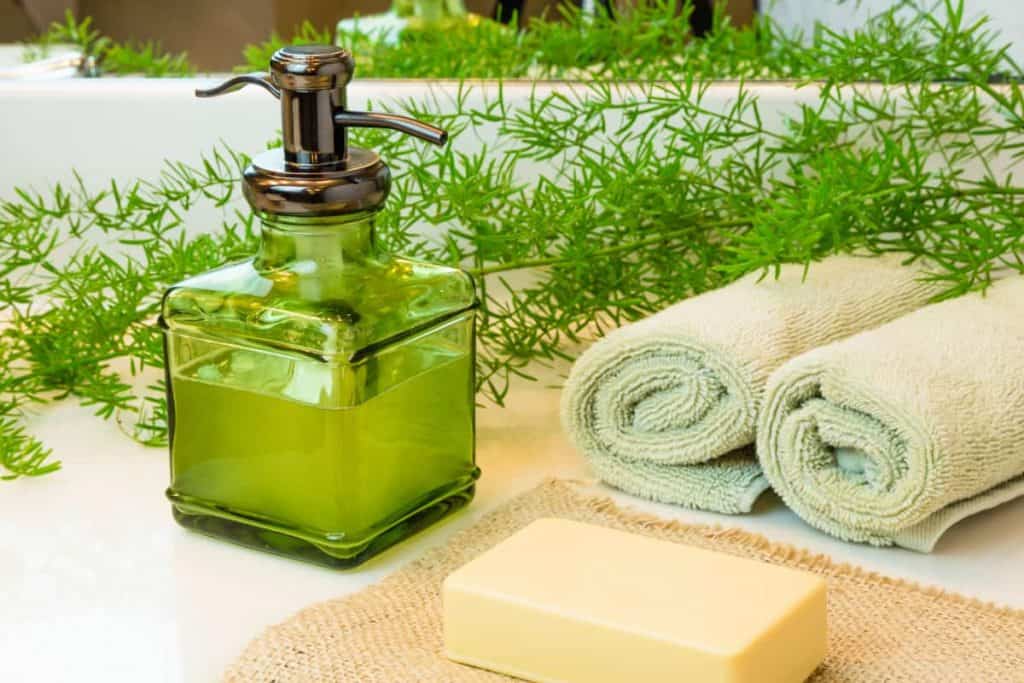
Castile soap: What’s so great about it?
Before we delve into things you should avoid doing with Castile, let’s look at what the fuss is all about.
- Plant-based: Many cleaning and beauty products use animal products. Not so with Castile. It’s a completely plant-based and vegan-friendly natural cleaner.
- Biodegradable: You can add this product to your green living toolkit. Composed of mainly vegetable oils, it lacks the synthetic ingredients found in other commercial soaps which allows this soap to break down easily and has minimal impact on the environment.
- Versatile: If you’re looking to declutter your cleaning products (and your beauty products), you can replace many of them with just one bottle (or bar) of Castile soap. While it’s available as bar soap, many opt for liquid Castile for its ease of use. The popular brand, Dr. Bronner’s markets its line of plant-based soaps as an “18-in-1” product. Use it for mopping floors, washing dishes, cleaning windows, as a DIY body wash, and more.
- Safe for most skin types: Mild and gentle, the vegetable oils used in most formulations jive well with most skin types, even those with sensitive skin or dry skin. There have been few (if any) reported cases of allergic reactions.
- Safe for most surfaces: Whether you’re cleaning laminate, stainless steel, wood, or stone, Castile is gentle and non-scratching.
- Affordable: A bottle of liquid Castile soap is meant to be diluted. That means that a little goes a long way and provides a great way to stretch your dollars. Mix your own soapy solution with distilled water plus any other (optional) essential oils.
- Free of harsh sulfates: Many commercial detergents on the market use a range of harsh chemicals and surfactants such as sodium lauryl sulfate (SLS), and sodium laureth sulfate (SLES). These may lead to skin irritation in some people. Castile opts instead for natural ingredients like coconut oil, which is high in cleansing power and also creates bubbles and lather.
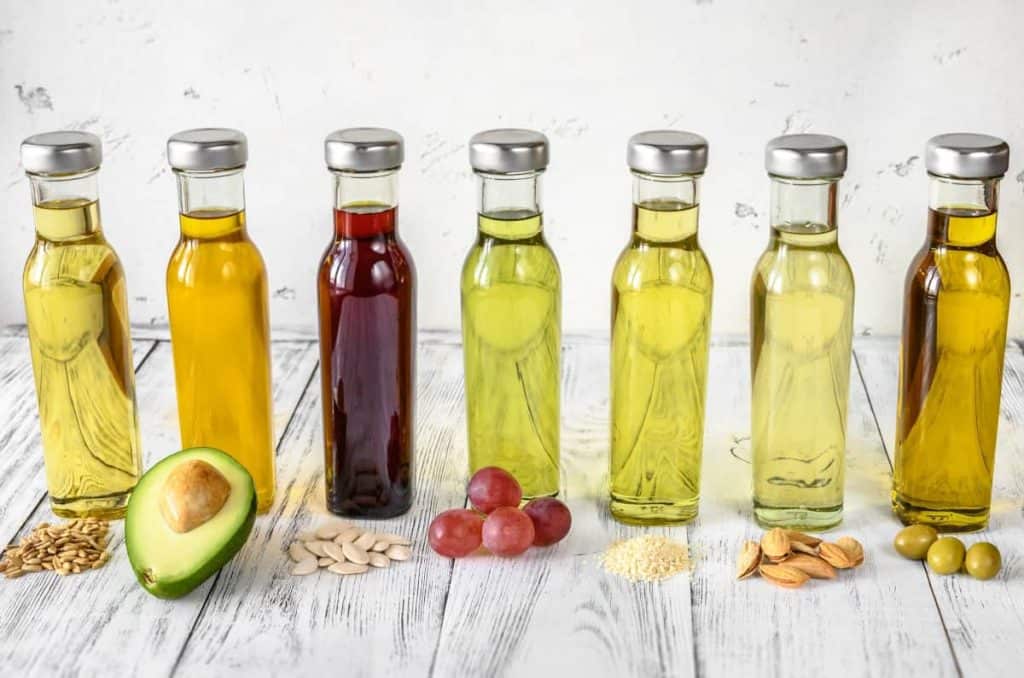
Credit: Vector State
Common uses for Castile soap
If you look up the many ways to use Castile soap, there are countless ideas. We’ve listed some of the most common ways below. The one area where I draw the line is at toothpaste. (Who wants to scrub their teeth with soap?!)
Ways to use Castile around the house
There are so many Castile soap uses, this traditional soap is a cleaning powerhouse. Virtually any surface that needs cleaning is fair game for this mild soap.
- Dish soap
- Mopping floors
- All purpose household cleaner
- Tile and tub cleaner
- Stainless steel cleaner
- Laundry soap
- Stain remover
- Window wash
- Toilet cleaner
- DIY pesticide
Ways to use Castile for personal care
8 Castile soap warnings: Things to keep in mind when using this versatile soap
While Castile soap has become the cure-all product for those in the health and wellness sphere (or those who’d like to be), it’s not perfect.
Using Castile soap properly comes with a bit of practice and understanding of its properties.
Let’s take a closer look.
#1: Remember to dilute properly
If you’re new to using this natural cleaner, it’s important to note that liquid formulations are concentrated Castile soap. This means that you must first dilute the soap before using.
While you don’t have to take exact measurements when creating your own cleaning or personal care solutions, it’s a good idea to roughly follow guidelines.
Depending on what you’re using it for, you may wish to work with a stronger concentration, or a milder one.
Dr. Bronner’s recommends the following dilution ratios:¹
- Washing dirty dishes: Add 1 part soap to 10 parts warm water.
- Multi-purpose household cleaner: Add ¼ cup soap to 1 quart (1 liter) of water in a spray bottle. Add ¼ teaspoon of your favorite essential oil (optional).
- Castile soap for laundry: You can use this natural soap as a laundry detergent alternative. For a large load in a regular washer, add between ⅓ to ½ of soap. Remember to add 1 cup of white vinegar to the rinse cycle. Use half the amount of soap for high-efficiency (HE) washers.
- Body wash: Add one small drop of soap to a loofah or washcloth and apply to wet skin.
#2: Keep out of eyes
While this may seem obvious, many people equate “natural and non-toxic” to mean it’s completely safe. As with all soaps, shampoos, and conditioners (handcrafted or commercial), it’s best to keep it out of your peepers.
While Castile soap is mild and non-toxic, it’s NOT tear-free. So keep that in mind if you’re using as a baby shampoo for your little one.
On the safety data sheet (SDS) for Dr. Bronner’s Peppermint Liquid Soap, it says if eye contact occurs, flush with water for 15 minutes.
#3: Don’t treat it like a disinfectant
A common question many people have is, does Castile soap kill germs? While this soap does a good job cleaning, it doesn’t disinfect or kill bacteria.
Soap acts as a surfactant (or surface-active agent) to reduce surface tension between water and oil/dirt particles. In other words, it allows oil/dirt molecules and bacteria to more easily wash away.
The mechanical action of rubbing your hands together (for at least 20–30 seconds) when washing your hands with soap, or the action of scrubbing a dirty dish, plays an integral role in getting things clean.
The Centers for Disease Control and Prevention (CDC) also doesn’t recommend using antibacterial soap for washing your hands as plain soap works just as well.²
So while soap helps clean and remove dirt, it doesn’t directly kill viruses or bacteria. So please don’t use Castile soap as a disinfectant in and of itself.
The U.S. Environmental Protection Agency (EPA) has some helpful definitions of what it means to clean vs. sanitize vs. disinfect: ³
- Cleaning: Using plain soap helps remove dirt and other organic matter from surfaces.
- Sanitizing: This extra step kills bacteria (but not viruses) on surfaces.
- Disinfecting: This process involves killing both bacteria and viruses on surfaces.
#4: Avoid adding anything acidic to this alkaline soap
Unless you’re performing a fun science experiment, avoid adding acidic ingredients to your Castile soap. This includes white vinegar, and other natural acids such as lemon juice, lime juice, etc.
Most Castile soaps have a pH of between 9 and 10. Citric acids like vinegar or lemon juice have a pH of 2. If you recall, the pH scale ranges from 0 to 14. A pH of 7 is neutral. Anything below pH 7 is acidic, and anything above is alkaline (or basic).

Combining an acid such as vinegar together with a base (Castile soap) causes a reaction. In this case, the reaction causes the soap to curdle, resulting in a messy, curdled solution. (And nobody wants that!)
Tip: The key to cleaning with liquid Castile soap is to use the soap separately FIRST, followed by the vinegar NEXT (there’s no need to mix the two together!).
#5: Don’t forget to follow up with a vinegar rinse
If you have hard water at home, you may notice that after wiping a shiny faucet with a soapy Castile solution, a white film, or residue, remains.
This leftover residue contains salts or minerals from the hard water.
This is normal. As a mild traditional soap, Castile is more prone to developing soap scum. (Some people with softer water may not experience any scum at all.)
Commercial detergents contain chelating agents which bind to metal ions in water and prevent them from forming a layer of (salty) soap scum.
Castile does not contain any of these chelating agents, which is why this soap scum may develop.
Luckily, there’s an easy fix for this: a vinegar rinse. Any type of white vinegar will do.
After washing surfaces such as sinks or tubs with a Castile solution, rinse the soapy water off with warm water.
Next, make a vinegar solution of about 1 cup of vinegar to 1 quart (approx. 1 liter) of water. Add to a spray bottle and let the acidic properties of vinegar cut through grease, and do their thing!
Note: If you’re tired of rinsing with an acidic chaser, you can check out Dr. Bronner’s Sal Suds, a plant-based detergent. This formulation is designed to work better with hard water and rinses clean without any mineral precipitate. Sal Suds is for cleaning around the home, not for body use.
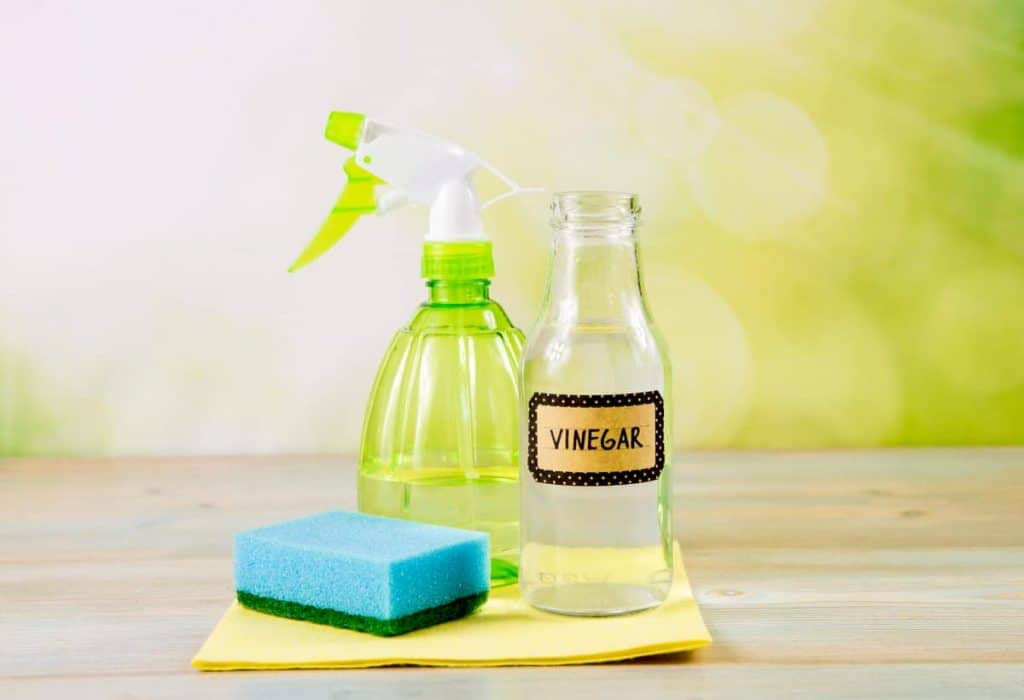
Credit: Deposit Photos
#6: Avoid using on color treated hair (or dry, damaged hair)
This next warning comes straight from Lisa Bronner herself (of Dr. Bronner’s). She does not recommend using an alkaline solution such as natural Castile on dyed or color treated hair.⁴
By nature, hair is acidic. Shampoos and conditioners that are acidic jive better with hair. Acidic products help close hair follicles, keeping hair shiny and smooth.
Alkaline products on the other hand open hair follicles. This means that any coloring will release and fade quickly. If you want to protect your dye job, stick with a color-safe shampoo.
This leads me to another (related) warning—ditto for dry, or damaged hair.
If you already have brittle or dry hair, it’s best to avoid using natural Castile soap for the time being. This may lead to further moisture loss and breakage.
Tip: When using Castile soap on normal or oily hair, it should be fine. Just remember to follow up with a diluted apple cider vinegar rinse.
#7: Use on plants sparingly
If you’re a proud plant parent, you may have heard of natural ways to rid your (plant) babies of pests—with a Castile spray.
Using too much Castile soap for plants can harm them.
With this DIY solution, a little goes a long way. Use just 1 tablespoon of liquid Castile soap to 1 quart (1 liter) of water. Add to a spray bottle and spray directly onto pests either in the early morning OR evening. This avoids the heat of the midday sun and allows the soapy solution to work its magic for longer.
Tip: This works for aphids, mealybugs, and spider mites. Avoid spraying on friendly insects such as ladybugs.
#8: Use within a reasonable time frame
Many good (and natural) things have a shorter shelf life. This rings true with Castile soap, which doesn’t contain any of the preservatives of its commercial detergent counterparts.
Does Castile soap expire?
While it’s completely shelf stable, Castile doesn’t last forever. For optimal usage, finish that bottle up within 3 years of the manufacture date, or within 2 years after opening.
While Castile doesn’t exactly “go bad” per se, it might lack some of the cleaning power that a newer bottle possesses.
When should you not use Castile soap?
All in all, there aren’t too many Castile soap cons (other than the ones we mentioned above about sometimes leaving a soap film, and reacting with an acidic ingredient).
In summary, there are a few instances when you may want to avoid using this plant-based soap:
- Don’t use it when you only have hard water to mix it with. Try diluting the soap with filtered or distilled water for best results. While technically you could use hard water, you’ll need to tackle the soap scum that’s left behind with a bit of elbow grease and an acidic rinse.
- Not recommended for colored hair, or dry hair.
- Use sparingly on plants.
Related questions
Does Castile soap contain lye?
If you look at the ingredients label of a bottle of Castile soap, you might see the word lye (or more specifically, potassium hydroxide lye, or sodium hydroxide lye).
While lye is an integral ingredient in the making of soap (both liquid and soap bars), you can rest assured that there’s no active lye in the finished product.
The saponification process (the science of making soap) involves combining a strong base with oils/fats to cause a chemical reaction which creates soap. When making liquid soap, we use potassium hydroxide; for solid bars of soap, we use sodium hydroxide.
Once the saponification process is complete, the byproduct is soap and glycerin. There is no active lye in finished soap as it has been converted into soap molecules. So that natural soap is perfectly safe to use on your skin!
What are some Castile soap alternatives?
Castile soap isn’t the only natural type of soap available. The following soaps may be suitable alternatives, depending on what you’re using it for.
- Coconut soap: Coconut oil creates a hard bar of soap with high cleansing properties. The downside is that it can be very drying on skin. Note: 100 percent coconut oil soap bars can be very drying on skin unless it is properly superfatted at a higher percentage (leaving excess oils to moisturize skin). Sometimes people like to use pure coco oil soap for laundry.
- Other olive oil soaps: There are many types of olive oil soaps that go by different names. Aleppo soap originates from Syria and is made of olive oil with laurel berry oil. Nabulsi soap is from city of Nablus in Palestine and uses virgin olive oil. Olive oil soaps are very mild and moisturizing, but lower on the cleansing scale.
- Goat’s milk: If you’re looking for a vegan soap, sadly goat’s milk doesn’t fit the bill. But, if you’re looking for a bar of soap that’s gently exfoliating and moisturizing, goat’s milk soap may be just the thing. Lactic acid helps slough off dead skin cells, leaving skin more rejuvenated.
Can you mix Castile soap with baking soda?
Yes! Combine these two basic (or alkaline) ingredients for a great cleaning duo. Baking soda is a mild abrasive powder that adds scrubbing action that’s gentle enough for sinks, tubs, and virtually any surface that needs a bit of extra cleaning.
Baking soda is also a natural whitener and odor neutralizer.
Can you use Castile soap to remove stains on clothes?
Yes, you can apply a small dab of undiluted Castile soap directly to the stained area. Gently work it in with a washcloth or old toothbrush. Let it sit for about 30 minutes before laundering. Don’t let the stain fully dry with the soap left on it!
Would you like more timeless tips via email?
Fun tips to help you live an independent, self-sustaining lifestyle. Opt-out at any time.


References
- Dr. Bronner’s, Dilutions Cheat Sheet for Dr. Bronner’s Pure-Castile Soap, https://www.drbronner.com/all-one-blog/2017/06/dilutions-cheat-sheet-dr-bronners-pure-castile-soap/. Accessed October 2023.
- Centers for Disease Control and Prevention (CDC), Frequent Questions About Hand Hygiene, https://www.cdc.gov/handwashing/faqs.html#soap. Accessed October 2023..
- U.S. Environmental Protection Agency (EPA), What’s the difference between products that disinfect, sanitize, and clean surfaces?, https://www.epa.gov/coronavirus/whats-difference-between-products-disinfect-sanitize-and-clean-surfaces. Accessed October 2023.
- Bronner, Lisa (20 November 2010). “From Shampoo to Soap – My Story,” Going Green. Accessed October 2023.

Author: Theresa Tesolin
Theresa is co-founder of RusticWise. She helps people unleash their inner DIY spirit by encouraging them to get dirty and make or grow something from scratch.


